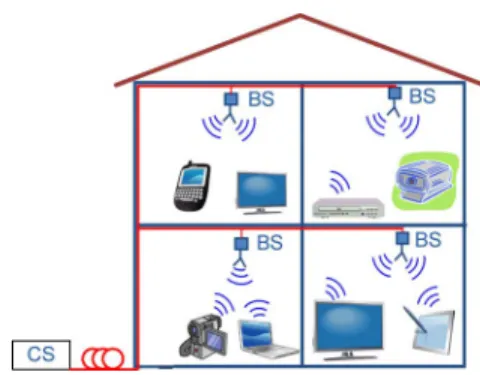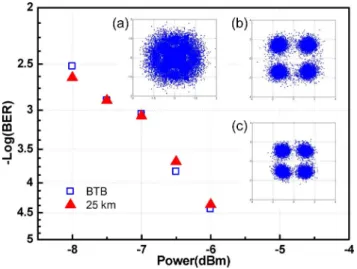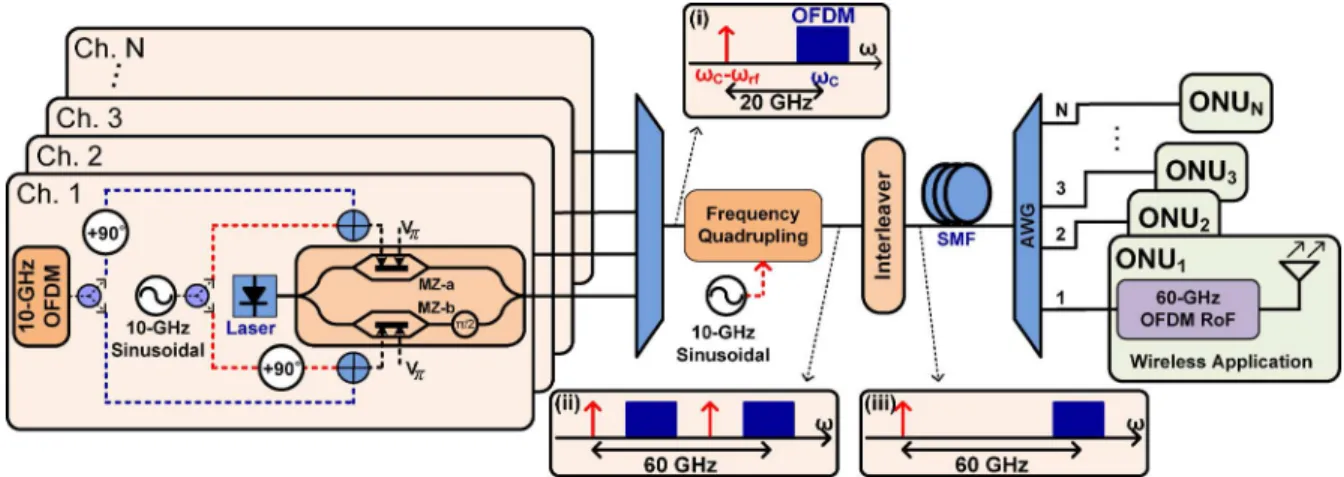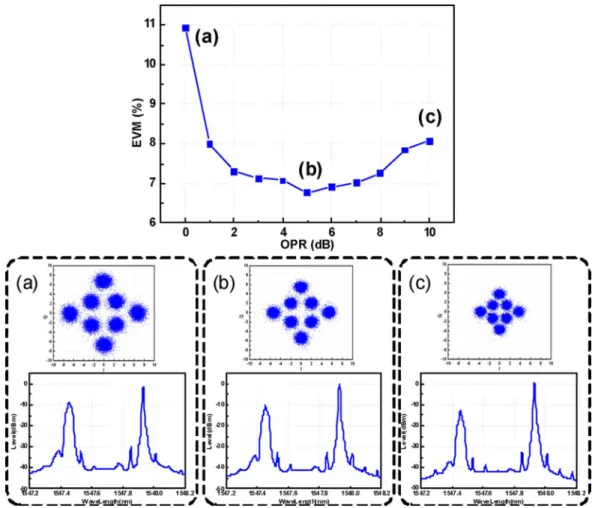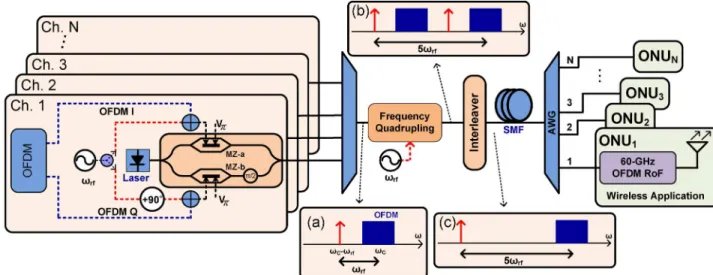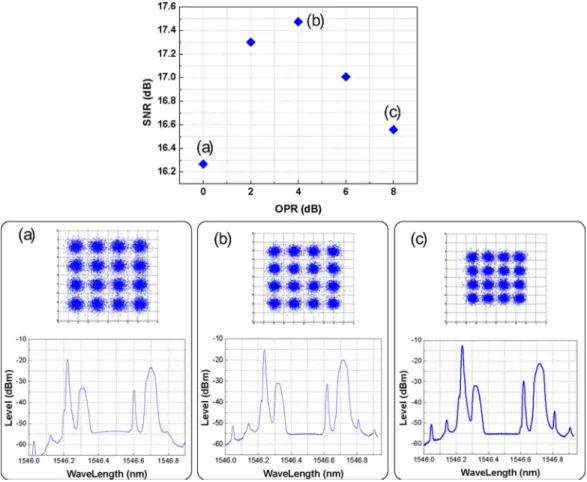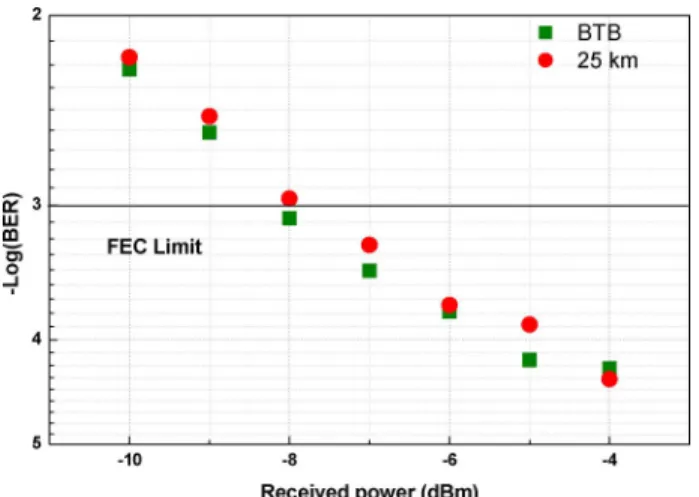Abstract—The increasing demand for wireless video-based
interactive and multimedia data services explains why 60-GHz millimeter-wave wireless system is a promising candidate to pro-vide multi-gigabit-per-second wireless services. While attempting to generate and transmit 60 GHz signals in a wireless system cost effectively and increase the spectral efficiency to facilitate multi-gi-gabit-per-second services, this work reviews three radio-over-fiber (RoF) systems based on optical frequency multiplication (up to 6 times) to reduce the bandwidth requirement of optical trans-mitters. Additionally, orthogonal frequency division multiplexing (OFDM) signals with multi-level modulation formats (16 QAM) are utilized to achieve an ultrahigh data rate of 28 Gbps within the 7-GHz license-free band and compensate for an uneven frequency response of 60-GHz RoF systems. Negligible power penalty fol-lowing 25-km standard single mode fiber (SSMF) transmission is observed, capable of significantly extending the service range to various applications within a building or campus.
Index Terms—Millimeter-wave, optical frequency
multiplica-tion, OFDM, radio-over-fiber.
I. INTRODUCTION
T
HE burgeoning growth of wireless and mobile com-munications has ushered in the development of various wireless communication systems that offer an enhanced data rate and mobility. Traffic patterns in access networks have changed rapidly from voice-based services to video-based interactive and multimedia data ones. Extending the carrier frequency to 60 GHz millimeter-wave offering a 7 GHz li-cense-free band is a promising candidate to provide multi-Gbps wireless services [1]–[21]. Among the several standards im-plemented to deliver multi-gigabit-per-second services for aManuscript received November 16, 2009; revised February 04, 2010; ac-cepted March 17, 2010. Date of publication April 22, 2010; date of current version August 02, 2010.. This work was supported by the National Science Council of the Republic of China, Taiwan, under Contract NSC 98-2218-E-009-021-, Contract NSC 003-MY3, Contract NSC 98-2221-E-155-004-MY3, and Contract NSC 97-2221-E-009-105-MY3.
C.-T. Lin is with the Institute of Photonic System, National Chiao Tung Uni-versity, Tainan 711, Taiwan (e-mail: jinting@mail.nctu.edu.tw).
J. Chen, P. T. Shih, and W.-J. Jiang are with the Department of Photonics, National Chiao Tung University, Hsinchu City 300, Taiwan.
S. Chi is with the Department of Photonics Engineering, Yuan Ze University, Jung-Li, TaoYuan 320, Taiwan.
Color versions of one or more of the figures in this paper are available online at http://ieeexplore.ieee.org.
Digital Object Identifier 10.1109/JLT.2010.2047712
Fig. 1. In-building 60-GHz RoF systems. (CS: central station, BS: base station).
60 GHz wireless system with 7 GHz license-free band include IEEE 802.15.3c, ECMA TC48, wireless HD/HDMI, WiGig, and IEEE 802.11 VHT. Given a high air-link loss at 60 GHz (10 m about 80 to 85 dB in modern office building [22]), the cell size of 60 GHz pico-cell is generally limited to 10 m, which is especially designed for in-building systems as shown in Fig. 1. Consequently, wireless access networks at 60 GHz require numerous base stations (BSs) to connect the access points. However, insufficient bandwidth and serious propagation loss make a conventional coaxial cable inadequate for the trans-mission of wireless signals in the microwave/millimeter-wave range. Therefore, the radio-over-fiber (RoF) system, which distributes RF signals from a central station (CS) to BS over an optical fiber, is a promising means of reducing the overall cost of a 60 GHz wireless access network owing to its nearly unlimited bandwidth and extremely low propagation loss. However, 60-GHz optical millimeter-wave generation remains a challenging task explaining its considerable interest.
Although the feasibility of the 60-GHz RoF system has been demonstrated using electro-absorption-modulator (EAM) [1]–[5], 60-GHz equipment and components are required, subsequently increasing overall system costs significantly. Moreover, the EAM modulation generates a double side-band (DSB) signal, which suffers from dispersion-induced performance fading. Generating a 60-GHz millimeter-wave signal with frequency doubling and overcoming the disper-sion-induced performance fading warrant the development of a double sideband with carrier suppression (DSB-CS) modulation scheme using Mach–Zehnder modulator (MZM).
However, typical DSB-CS modulation schemes support only an on-off-keying (OOK) modulation format [6], [7] and OOK format cannot fulfill next generation wireless multimedia ser-vices with a target bit rate reaching 10 Gb/s within the 7-GHz license-free band at 60 GHz. Although [8] can support vector signals, the beat noise of two optical modulated sidebands limits the performance the generated vector signals.
Owing to a high tolerance against fiber dispersion and po-larization-mode dispersion, orthogonal frequency division mul-tiplexing (OFDM) format, which has been widely utilized in the current wireless communication, has attracted considerable attention recently for optical high-capacity long-haul commu-nication [23]–[26], multimode fiber links [27]–[31], as well as plastic optical fiber links [32], [33]. Additionally, a high spec-tral efficiency and flexibility of OFDM makes it attractive for narrowband applications beyond the 10-Gb/s regime. Due to or-thogonal characteristic of each subcarrier of OFDM signals, the OFDM system has a higher spectral efficiency than single-car-rier DSB system does, as well as a higher data rate within the 7-GHz license-free spectrum at 60 GHz. Moreover, an uneven frequency response of 60-GHz systems can be compensated for by using a simple one-tape equalizer. However, the conventional electrical generation and up-conversion of the multilevel OFDM signal at a millimeter-wave band significantly increase the com-plexity and cost of 60-GHz RoF systems.
While attempting to generate and transmit 60 GHz signals in a wireless system cost effectively and increase the spectral efficiency to support multi-gigabit-per-second services, this work reviews three optical frequency multiplication schemes to reduce the bandwidth requirement of optical 60-GHz OFDM transmitters and ensure the high signal to noise ratio (SNR) of generated 60-GHz OFDM signals. Data rates exceeding 10 Gbps (up to 28 Gbps) are demonstrated experimentally. Additionally, the proposed three OFDM systems do not incur periodic fading due to fiber dispersion because the generated optical 60-GHz OFDM signal consists of an OFDM-modulated sideband and an un-modulated sideband.
The rest of this paper is organized as follows. Section II introduces the frequency doubling scheme with tandem single sideband (TSSB) modulation. Section III then describes the frequency sextupling scheme. Next, Section IV presents the frequency quintupling scheme using all-optical up-conversion. Additionally, Section V compares the three proposed schemes in terms of highest achievable data rate, cost, and complexity. Conclusions are finally drawn in Section VI.
II. FREQUENCYDOUBLINGSCHEMEWITHTSSB MODULATION
A. Concept of the Frequency Doubling Scheme
Fig. 2 shows the conceptual diagram of the proposed fre-quency doubling modulation system using TSSB modulation. TSSB modulation scheme is achieved using a dual-electrode MZM biased at the quadrature point [19]. An OFDM-modu-lated upper optical sideband and an un-moduOFDM-modu-lated lower optical sideband are performed by adding two additional 90 phase shifts to the upper path of the OFDM signal and the lower path of the sinusoidal signal, respectively. The OFDM signal and sinusoidal signal are then combined, as shown in insets (iii)
and (iv) of Fig. 2 and sent into the dual-electrode MZM. At MZM output, a TSSB optical spectrum that consists of the orig-inal optical carrier , OFDM-modulated optical sideband
, and un-modulated optical sideband
are obtained, as shown in inset (v) of Fig. 2. At the remote node, following the transmission of a standard single mode fiber (SSMF), the original optical carrier is separated from the other two sidebands by using a fiber Bragg grating (FBG) and an optical circulator, as shown in insets (vi) and (vii) of Fig. 2. The original optical carrier can be utilized for an uplink application. The un-modulated and OFDM-modulated optical sidebands are received for wireless applications. Notably, fre-quency doubling can be achieved since equals . Optical
power ratio ( , where
and are the average powers of the un-modulated and OFDM-modulated optical sidebands) between the un-modu-lated and OFDM-moduun-modu-lated optical sidebands is an important factor for optimizing the receiver performance [34]. Since the un-modulated and OFDM-modulated optical sidebands are generated from two driving signals, OPR can be freely adjusted to optimize the receiver performance. Based on the proposed TSSB modulation scheme, high spectral efficiency vector signals can be utilized, and the proposed system does not incur dispersion induced performance fading.
B. Experimental Setup of the Frequency Doubling Scheme Fig. 3 illustrates the experimental setup. A tunable laser is utilized as the optical source. The QPSK (quadrature phase-shift keying)-OFDM signal is generated at baseband (BB) from an arbitrary waveform generator (AWG, Tektronix® AWG7102) with the following parameters: sampling rate of 20 GSa/s for the digital to analog converter (DAC); inverse-fast-Fourier transform (IFFT) size of 256; subcarrier frequency separation of 78.125 MHz, and 44 subcarriers generated at the baseband, as shown in inset (i) of Fig. 3. After up-conversion using an electrical mixer with a 30-GHz sinusoidal signal, a 30-GHz QPSK-OFDM driving signal with 88 subcarriers is obtained, as shown in inset (ii) of Fig. 3. This produces two OFDM sidebands centered at 30 GHz, with a combined bandwidth of 7 GHz. Both sidebands are transmitted over the RoF system. Since the subcarriers are transmitted independently, and de-modulated independently at the receiver, the total bit-rate of the emulated 7 GHz-wide OFDM signal is double that of the original OFDM signal generated by the AWG. Hence, the total data rate of the 30-GHz QPSK-OFDM signal is 13.75 Gb/s.
Subsequently, both 30-GHz OFDM-QPSK and sinusoidal signals are divided into two paths using two 90 hybrid couplers. The combined signals are amplified to drive the dual-electrode MZM which is biased at the quadrature point. At MZM output, the optical power before fiber transmission is boosted using an erbium doped fiber amplifier (EDFA). The generated optical TSSB OFDM signal is transmitted over 25-km SSMF, and the original optical carrier and two optical sidebands are separated for up-link and wireless applications, respectively, by using an optical fiber Bragg grating. The two optical sidebands are received using a V-band photo-diode (PD) for optical-electrical conversion. Insets (1)–(3) of Fig. 3 show the generated optical spectrum of TSSB OFDM signal
Fig. 2. Conceptual diagram of the frequency doubling system using TSSB modulation.
Fig. 3. Experimental setup of the frequency doubling system using TSSB modulation.
and the optical spectra of the signals after filtering. The gen-erated electrical 60-GHz OFDM signals are down-converted using an electrical mixer with a 55-GHz local oscillator (LO) signal and then sent into a digital signal oscilloscope to capture the time domain waveform for off-line demodulation. The demodulation process includes synchronization, fast-Fourier transform (FFT), one-tap equalizer, and QPSK demodulator. Based on the multi-carrier characteristic of the OFDM signal, one-tap equalizer can compensate for the uneven frequency response of the 60-GHz components efficiently. Bit error rate (BER) is estimated from the constellation diagrams to evaluate the signal performance.
C. Experimental Results of the Frequency Doubling Scheme OPR of the optical un-modulated sideband to OFDM-modu-lated sideband significantly affects the receiver performance. In the conventional SSB modulation scheme, OPR cannot be easily adjusted. An additional narrow band optical filter is normally required to suppress the original optical carrier and enhance the
receiver performance [34]. The proposed TSSB system gener-ates the un-modulated and OFDM-modulated optical sidebands from two driving signals. Therefore, OPR can be adjusted by controlling the amplitude of driving signals. Fig. 4 illustrates the QPSK-OFDM BER versus OPR curves. The best receiver per-formance is obtained with 6-dB OPR, where the power of the un-modulated sideband is 6 dB higher than that that OFDM-modulated sideband. The insets of Fig. 4 show the constella-tion diagrams with OPRs of dB, 6 dB and 11 dB. Notably, OPR in OFDM systems are higher than a conventional signal carrier system, which has 0-dB optimal OPR [34]. Due to the high peak-to-average-power-ratio (PAPR) property, OFDM sig-nals are sensitive to the nonlinearity of the transmission systems, while the signal performance can be easily degraded. Therefore, increasing the optical power of the un-modulated optical side-band can effectively enhance the OFDM signal performance.
Fig. 5 shows the BER curves and constellation diagrams of the 13.75-Gb/s QPSK OFDM down-link signals. Without using the one-tap equalizer, the OFDM signal cannot be recovered due
Fig. 4. OPR versus0 log(BER) of the OFDM signal.
Fig. 5. BER curves and constellation diagrams of the down-link transmission. (a) Back-to-back without one-tap equalizer; (b) back-to-back with one-tap equalizer; (c) 25-km SSMF.
to an uneven amplitude and phase frequency response of the 60 GHz system, inset (a) of Fig. 5. Notably, the QPSK-OFDM signal can be recovered after using the one-tap equalizer. No significant signal distortion of the constellation diagram is ob-served after a transmission of 25-km SSMF. The receiver power penalty after the SSMF transmission can be ignored.
III. FREQUENCYSEXTUPLINGSCHEME
A. Concept of the Frequency Sextupling Scheme
There are three main drawbacks of the frequency doubling method discussed earlier. Firstly, the electrical mixer will sig-nificantly degrade the signal quality. Secondly the modulator is not operated at linear E-field region. For an OFDM signal which is sensitive to PAPR, this considerably limits the modu-lation index. Thirdly, at transmitter, expensive components with frequency up to 35 GHz are needed. To address these issues, a new scheme is proposed. Fig. 6 shows the conceptual diagram of the 60-GHz vector signal generation system with frequency sextupling [20]. The proposed system consists of two stages with two dual-parallel Mach–Zehnder modulators (DP-MZM). An optical single sideband with carrier suppression (SSB-CS) scheme signal is generated during the first stage using the first DP-MZM [35]. A sinusoidal signal and an intermediate frequency vector data signal are combined as the driving signal. Following the first DP-MZM, an optical un-modulated subcarrier is generated at the lower sideband and an OFDM -modulated signal is generated at the upper sideband (inset (i) of Fig. 6). Notably, frequency doubling is achieved after the first stage. The second stage is an optical up-conversion system, which comprises an optical millimeter-wave generation system with frequency quadrupling using the other DP-MZM [36]. Following the optical up-conversion, both the un-modulated and data-modulated optical sidebands are up-converted with a frequency four times higher than that of the up-conversion system driving signal, as shown in inset (ii) of Fig. 6. Next,
Fig. 6. Conceptual diagram of the 60-GHz vector signal generation system with frequency sextupling.
Fig. 7. Experimental setup of the proposed system.
two desired optical sidebands with the frequency sextupling obtained are selected using an optical interleave (inset (iii) of Fig. 6). Since the generated optical signal consists of an un-modulated subcarrier and a data-modulated subcarrier, the proposed scheme can support high spectral efficiency vector signals, including M-ary phase shift keying (PSK), quadrature amplitude modulation (QAM), and OFDM signals. Addition-ally, the proposed scheme does not incur dispersion induced performance fading. Since un-modulated and data-modulated optical sidebands are generated from two driving signals, the receiver performance can be optimized by controlling the optical power ratio (OPR) between two optical sidebands [34]. Owing to the frequency sextupling using optical up-conversion, signal processing can be handled using 10-GHz components with high reliability and low costs.
B. Experimental Setup of the Frequency Sextupling Scheme Fig. 7 illustrates the experimental setup of the proposed 60-GHz OFDM generating system with frequency sextupling. A DFB laser is utilized as the optical source. In the first stage, the sub-MZMs (MZ1-a and MZ1-b) of the DP-MZM are biased at the minimum transmission point, while the main MZM is biased at the quadrature point to introduce a 90 phase difference. The OFDM signals are generated at baseband (BB) using an AWG (Tektronix® AWG7102) with the following parameters: sampling rate of 20 GSa/s for the DAC, IFFT size of 256, subcarrier frequency separation of 78.125 MHz, 44 subcarriers generated at BB, and a bandwidth
of 3.4375 GHz. The BB OFDM signals are then up-con-verted using an electrical mixer with a 10-GHz sinusoidal signal, subsequently obtaining 10-GHz OFDM signals with 6.875-GHz bandwidth and 88-subcarriers. The total data rate of the emulated 8-QAM-OFDM signal is 20.625 Gb/s. Next, the un-modulated optical sideband is generated using another 10-GHz sinusoidal signal. The 10-GHz OFDM signal and 10-GHz sinusoidal signal are divided into two paths (upper path and lower path). Additionally, the modified SSB signal using the SSB-CS modulation scheme is generated by adding a 90 phase delay to the upper path of the OFDM signal and the lower path of the 10-GHz sinusoidal signal. The upper path and lower path signals are combined and sent to DP-MZM. At the output of the first stage, a 20-GHz modified SSB signal is obtained (inset (1) of Fig. 7). The 20-GHz OFDM signal is then sent to the second stage for optical up-conversion. The second DP-MZM is utilized for optical up-conversion with frequency quadrupling. The sub-MZMs (MZ2-a and MZ2-b) are biased at the maximum transmission point while the main MZM is biased at the minimum transmission point. The 10-GHz driving signal of the second DP-MZM is divided into two paths, and a 90 phase delay is added to the lower path signal. After the second DP-MZM, both the un-modulated and OFDM-modu-lated optical sidebands of the 20-GHz modified SSB signal are up-converted. Inset (2) of Fig. 7 shows the optical spectrum. Next, a 60-GHz modified SSB OFDM signal is generated using an optical interleaver to select the desired optical sidebands (inset (3) of Fig. 7). Following transmission of 25-km SSMF, the optical signal is received using a V-band PD. The received
Fig. 8. EVM versus OPR curve and constellation diagrams of the 8 QAM-OFDM signal.
60-GHz OFDM signals are down-converted to 5-GHz using an electrical mixer with 55-GHz LO signals, and sent into a digital signal oscilloscope to retrieve the time domain waveform for off-line demodulation using a Matlab program. Demodulation of the Matlab program includes synchronization, FFT, a one-tap equalizer, and a demodulator.
C. Experimental Results of the Frequency Sextupling Scheme By controlling the driving signal, the OPR can be freely adjusted in the proposed modified SSB system. Fig. 8 shows the error vector magnitude (EVM) versus OPR curve and related constellation diagrams of the 8-QAM-OFDM signal. The EVM is defined as %
, where and are the received and ideal symbols, respectively, and is the maximum symbol vector in the constellation. The best EVM of 8-QAM OFDM signals is obtained with 5-dB OPR, where the power of the un-modulated sideband is 5 dB higher than that of OFDM-modulated sideband.
Fig. 9 shows the EVM curves of the transmission results of the 8-QAM-OFDM signal. Following transmission of 25-km SSMF, the EVM penalty can be ignored. Without using the one-tap equalizer, the OFDM signal cannot be recovered due to uneven amplitude and phase frequency response of the 60 GHz
Fig. 9. EVM curves of the 8-QAM-OFDM signal fiber transmission results.
components as shown in the inset (a) of Fig. 9. After using the one-tap equalizer, the 8-QAM-OFDM signal can be recovered. No significant signal distortion of the constellation diagram is observed after transmission of 25-km SSMF from insets (b) and (c) of Fig. 9. The receiver power penalty after the SSMF trans-mission can be ignored.
Fig. 10. Conceptual diagram of the 60-GHz optical/wireless system using all-optical up-conversion.
Fig. 11. Experimental setup of the proposed system.
IV. FREQUENCY QUINTUPLING SCHEMEWITH
ALL-OPTICALUP-CONVERSION
A. Concept of the Frequency Quintupling Scheme
Though the second scheme is operated at linear E-field region, an electrical mixer is still needed. A new all optical up-conversion scheme is proposed to resolve this problem. Fig. 10 schematically depicts the proposed frequency quintu-pling system employing all-optical up-conversion. The pro-posed 60-GHz OFDM transmitter consists of two DP-MZMs for optical up-conversion and frequency quadrupling, respectively. For optical up-conversion, OFDM I and Q signals are sent to MZ-a and MZ-b of the first DP-MZM, respectively. Next, both MZ-a and MZ-b are biased at the null point to achieve high optical modulation depth and operate in the E-field linear region of MZM. Additionally, direct-detection OFDM signals are realized by inserting an optical subcarrier as a remote het-erodyne scheme through the use of single side band modulation with carrier suppression [35]. Therefore, according to inset (a) of Fig. 10, the generated optical OFDM signal consisting of an un-modulated subcarrier and an OFDM-modulated carrier can be converted into electrical RF OFDM signals by square-law PD detection. Next, the generated optical OFDM signal is up-converted by using the frequency quadrupling method [36] (inset (b) of Fig. 10). Following an interleaver to filter out the unwanted sideband, frequency quintupling is achieved, as
shown in inset (c) of Fig. 10. Notably, the proposed OFDM transmitter does not require an electrical mixer with a typical noise figure (NF) of more than 8 dB for up-conversion to 60 GHz. This is an extremely important feature for high spectral efficiency OFDM signals (i.e., 16-QAM and above) that require a higher SNR. Additionally, the relative intensity between the un-modulated and OFDM-modulated subcarriers can be modi-fied by varying the individual power of the electrical sinusoidal and OFDM signals to optimize the performance of the optical RF signals [34].
B. Experimental Setup of the Frequency Quintupling Scheme The OFDM signals are generated by an AWG (Tektronix® AWG7102) using a Matlab® software program. The sample rate and DAC resolution of AWG are 10 GSa/s and 8 bits, re-spectively. The IFFT length is 64. A 156.25-MSym/s 16-QAM symbol is encoded at 45 channels, i.e., channels 3–25 and 42–63, with the remaining nine channels set to zero. Therefore, an optical 28-Gb/s 16-QAM OFDM signal with 45 subcarriers and occupying a total bandwidth of 7 GHz can be generated. To realize the optical direct-detection OFDM signal, a new optical subcarrier is generated at the lower sideband of the original carrier by 12 GHz (inset (b) of Fig. 11). Notably, the undesired sideband suppress ratio is greater than 28 dB, which only slightly influences the performance of the generated OFDM signals. The generated OFDM signal is up-converted by using
Fig. 12. SNR versus different OPRs between optical OFDM-modulated and un-modulated sidebands.
optical frequency quadrupling method. After a 50/100 GHz op-tical interleaver, 28-Gb/s 16-QAM OFDM signal at 60 GHz with frequency quintupling is generated (inset (c) of Fig. 11). Notably, the transmission penalty of the system is evaluated using a 25-km SSMF. Following square-law PD detection, an electrical 28-Gb/s 16-QAM OFDM signal at 60 GHz is gen-erated and down-converted to 5 GHz, as shown in inset (d) of Fig. 11. The down-converted OFDM signal is retrieved by a Tektronix®DPO 71254 with a 50-GSy/s sample rate and a 3-dB bandwidth of 12.5 GHz. Additionally, the OFDM signal is demodulated using an off-line DSP program. The demodu-lation process includes synchronization, FFT, one-tap equaliza-tion, and QAM symbol decoding. Finally, the BER performance is calculated from the constellations.
C. Experimental Results of the Frequency Quintupling Scheme Fig. 12 illustrates the SNR of the 16-QAM OFDM signals versus different OPRs of the un-modulated subcarrier to the OFDM-encoded subcarrier as optical powers of 60-GHz OFDM signals are normalized before detection. The optimal OPR is 4 dB, where the power of the un-modulated sideband is 4 dB higher than that of the OFDM -modulated sideband.
Fig. 13 shows the 16-QAM constellation diagrams before and after the one-tap equalizer in back-to-back (BTB) and following SSMF transmission cases. Both the frequency response of var-ious millimeter-wave components at 60 GHz and fiber disper-sion are combated using the equalizer in OFDM transceiver. Since the proposed OFDM transmitter can generate high-pu-rity two-tone lightwave, the generated OFDM signals do not
Fig. 13. Constellations (04 dBm) of the OFDM signals. (a) BTB w/o equal-izer, (b) BTB w/equalequal-izer, (c) 25 km w/equalizer.
incur periodic fading due to fiber dispersion. Only in-band tortion of the OFDM-encoded subcarrier induced by fiber dis-persion is considered. Since the symbol rate of each subcarrier is only 156.25 MSym/s, the fiber chromatic penalty can be ig-nored. Fig. 14 displays the BER curves of the 28-Gb/s 16-QAM OFDM signals using optimal OPRs after transmission exceeds 25-km SMF. The sensitivity penalties due to the fiber transmis-sion are negligible.
Fig. 14. BER curves of the OFDM signals. TABLE I
COMPARISON OFTHREEPROPOSEDSYSTEMS
V. COMPARISON
Table I shows the comparison of three proposed systems. Though TSSB is the simplest and requires only one dual-elec-trode MZM, there are several drawbacks that limit the system performance. Firstly, with only frequency doubling, expensive electrical components are needed. The OFDM signal is pro-cessed at 30 GHz and the bandwidth of the transmitter is 33.5 GHz. Secondly, instead of operating at linear E-field region, TSSB modulation is operated at the linear amplitude region of the dual-electrode MZM which is biased at the quadrature point. This nonlinear transfer curve will increase the PAPR-induced
Compared with TSSB scheme, the frequency sextupling scheme offers few important improvements. First, the band-width of the optical OFDM transmitter is less than 13.5 GHz and OFDM signals are processed at lower frequency, i.e., 6.5–13.5 GHz. Secondly, to mitigate the nonlinear PAPR issue, the sub-MZMs are biased at the null point which is the linear re-gion of the electrical field. Therefore, the frequency sextupling system can provide 60-GHz OFDM RoF signals with higher SNR. 20.625-Gbps 8-QAM-OFDM signal generation is exper-imentally demonstrated with negligible receiver power penalty following 25-km SSMF transmission. Two stages of DP-MZMs are required which will increase the system complexity.
To further improve the system performance, the frequency quintupling scheme is proposed. This scheme has the lowest bandwidth requirement of the optical OFDM transmitter (i.e., 12 GHz). Since no electrical mixer with a typical NF of more than 8 dB is required to up-convert OFDM driving signals, the OFDM signal is processed at baseband to ensure higher SNR. Moover, the external modulator is also operated at E-field linear re-gion. Therefore, the frequency quintupling scheme can support highest modulation format and 28-Gbps 16-QAM OFDM sig-nals are experimentally demonstrated. Nevertheless, two stages of DP-MZMs which increase the system complexity are also re-quired in the all-optical up-conversion system.
Notably, although two stages of signal generation and optical up-conversion are required in frequency sextupling and quintu-pling systems, WDM up-conversion can be potentially achieved in these two systems. All WDM channels share only one optical up-conversion system which is based on the wavelength inde-pendent frequency quadrupling system [37], and the system cost can be significantly reduce.
VI. CONCLUSION
This work demonstrates the feasibility of ultra broadband 60-GHz RoF systems beyond 10 Gbps based on optical fre-quency multiplication. Frefre-quency doubling, sextupling, and quintupling schemes are also developed to reduce the bandwidth requirement of optical transmitter. Since the driving signals are processed at a lower frequency, the proposed schemes can provide better SNRs of generated electrical 60-GHz signals. Furthermore, OFDM signals with high modulation formats are utilized to achieve a data rate (exceeding OR of more than) 10 Gbps within the 7-GHz license-free band and compensate for an uneven frequency response of 60-GHz RoF systems. Hence, extremely high data rates of up to 28 Gbps achieved.
Moreover, the power penalty can be ignored after 25-km SSMF transmission.
REFERENCES
[1] Y. X. Guo, B. Luo, C. S. Park, L. C. Ong, M.-T. Zhou, and S. Kato, “60 GHz radio-over-fiber for Gbps transmission,” in Proc. Global Symp.
Millimeter Waves (GSMM), 2008, pp. 41–43.
[2] C. S. Park, Y. X. Guo, L. C. Ong, Y. K. Yeo, Y. X. Wang, M. T. Zhou, and H. Harada, “Application of an electroabsorption modulator in radio-over-fiber networks invited,” J. Opt. Netw., vol. 8, pp. 146–155, Feb. 2009.
[3] T. Taniguchi, N. Sakurai, K. Kumozaki, and T. Imai, “Full-duplex 1.0 Gbit/s data transmission over 60 GHz radio-on-fiber access system based on the loop-back optical heterodyne technique,” J. Lightw.
Technol., vol. 26, no. 13, pp. 1765–1776, Jul. 2008.
[4] J. H. Seo, C. S. Choi, Y. S. Kang, Y. D. Chung, J. Kim, and W. Y. Choi, “SOA-EAM frequency up/down-converters for 60-GHz bidirectional radio-on-fiber systems,” IEEE Trans. Microw. Theory Tech., vol. 54, no. 2, pp. 959–966, Feb. 2006.
[5] T. Kuri, K. Kitayama, and Y. Takahashi, “A single light-source con-figuration for full-duplex 60-GHz-band radio-on-fiber system,” IEEE
Trans. Microw. Theory Tech., vol. 51, no. 2, pp. 431–439, Feb. 2003.
[6] M. Weiß, M. Huchard, A. Stöhr, B. Charbonnier, S. Fedderwitz, and D. S. Jäger, “60-GHz photonic millimeter-wave link for short- to medium-range wireless transmission up to 12.5 Gb/s,” J. Lightw. Technol., vol. 26, no. 15, pp. 2424–2429, Aug. 1, 2008.
[7] H. C. Chien, A. Chowdhury, Z. Jia, Y. T. Hsueh, and G. K. Chang, “60 GHz millimeter-wave gigabit wireless services over long-reach passive optical network using remote signal regeneration and upconversion,”
Opt. Exp., vol. 17, no. 5, pp. 3036–3041, Mar. 2, 2009.
[8] Z. Jia, J. Yu, D. Qian, G. Ellinas, and G. K. Chang, “Experimental demonstration for delivering 1-Gb/s OFDM signals over 80-km SSMF in 40-GHz radio-over-fiber access systems,” Proc. OFC 2008, Paper JWA 108.
[9] M. Huchard, M. Weiß, A. Pizzinat, S. Meyer, P. Guignard, and B. Char-bonnier, “Ultra-broadband wireless home network based on 60-GHz WPAN cells interconnected via RoF,” J. Lightw. Technol., vol. 26, no. 15, pp. 2364–2372, Aug. 1, 2008.
[10] G. H. Nguyen, B. Cabon, and Y. Le Guennec, “Generation of 60-GHz MB-OFDM signal-over-fiber by up-conversion using cascaded ex-ternal modulators,” J. Lightw. Technol., vol. 27, pp. 1496–1502, Jun. 2009.
[11] W. K. Kim, S. W. Kwon, W. J. Jeong, G. S. Son, K. H. Lee, W. Y. Choi, W. S. Yang, H. M. Lee, and H. Y. Lee, “Integrated optical modulator for signal up-conversion over radio-on-fiber link,” Opt. Exp., vol. 17, pp. 2638–2645, Feb. 2009.
[12] Y. T. Hsueh, Z. S. Jia, H. C. Chien, J. J. Yu, and G. K. Chang, “A novel bidirectional 60-GHz radio-over-fiber scheme with multiband signal generation using a single intensity modulator,” IEEE Photon. Technol.
Lett., vol. 21, pp. 1338–1340, Sep. 2009.
[13] C. S. Park, Y. Guo, Y. K. Yeo, Y. Wang, L. C. Ong, and S. Kato, “Fiber-optic 60-GHz wireless downlink using cross-absorption modulation in an EAM,” IEEE Photon. Technol. Lett., vol. 20, pp. 557–559, Mar. –Apr. 2008.
[14] A. Ng’oma, M. Sauer, D. Thelen, J. George, and Ieee, “Data throughput tripling by feed-forward equalization and photonic QPSK in a 7 Gbps single-carrier RoF link at 60 GHz,” in Proc. Int. Topical Meeting
Microwave Photonics/2008 Asia-Pacific Microwave Photonics Conf.,
Gold Coast, Australia, 2008, pp. 213–216.
[15] M. Mohamed, X. P. Zhang, B. Hraimel, and K. Wu, “Frequency six-upler for millimeter-wave over fiber systems,” Opt. Exp., vol. 16, pp. 10141–10151, Jul. 2008.
[16] Z. S. Jia, J. J. Yu, Y. T. Hsueh, A. Chowdhury, H. C. Chien, J. A. Buck, and G. K. Chang, “Multiband signal generation and dispersion-tol-erant transmission based on photonic frequency tripling technology for 60-GHz radio-over-fiber systems,” IEEE Photon. Technol. Lett., vol. 20, pp. 1470–1472, Sep.–Oct. 2008.
[17] Y. Le Guennec, G. Maury, J. P. Yao, and B. Cabon, “New optical microwave up-conversion solution in radio-over-fiber networks for 60-GHz wireless applications,” J. Lightw. Technol., vol. 24, pp. 1277–1282, Mar. 2006.
[18] A. Ng’oma, M. Sauer, F. Annunziata, W. J. Jiang, C. T. Lin, J. Chen, P. T. Shi, and S. Chi, “14 Gbps 60 GHz RoF link employing a simple system architecture and OFDM modulation,” in Proc. of IEEE MWP
2009 Conf. 2009, Valencia, Spain, Oct. 2009.
[19] P. T. Shih, C. T. Lin, W. J. Jiang, Y. H. Chen, J. Chen, and S. Chi, “Full duplex 60-GHz RoF link employing tandem single sideband modula-tion scheme and high spectral efficiency modulamodula-tion format,” Opt. Exp., vol. 17, no. 22, pp. 19501–19508, Oct. 26, 2009.
[20] P. T. Shih, C. T. Lin, H. S. Huang, W. J. Jiang, J. Chen, A. Ng’oma, M. Sauer, and S. Chi, “13.75-Gb/s OFDM signal generation for 60-GHz RoF system within 7-GHz license-free band via frequency sextupling,” in Proc. Eur. Conf. Opt. Commun. (ECOC 2009), Sep. 2009, Paper 4.5.4.
[21] C. T. Lin, E. Z. Wong, W. J. Jiang, P. T. Shih, J. Chen, and S. Chi, “28-Gb/s 16-QAM OFDM radio-over-fiber system within 7-GHz li-cense-free band at 60 GHz employing all-optical up-conversion,” in
Proc. Conf. Lasers and Electro-Optics (CLEO 2009), May 31, 2009,
Paper CPDA8.
[22] S. Geng, J. Kivinen, X. Zhao, and P. Vainikainen, “Millimeter-wave propagation channel characterization for short-range wireless commu-nications,” IEEE Trans. Veh. Technol., vol. 58, no. 1, pp. 3–13, Jan. 2009.
[23] A. J. Lowery, L. B. Du, and J. Armstrong, “Performance of op-tical OFDM in ultralong-haul WDM lightwave systems,” J. Lightw.
Technol., vol. 25, no. 1, pp. 131–138, Jan. 2007.
[24] S. L. Jansen, I. Morita, T. C. W. Schenk, and H. Tanaka, “121.9-Gb/s PDM-OFDM transmission with 2-b/s/Hz spectral efficiency over 1000 km of SSMF,” J. Lightw. Technol., vol. 27, pp. 177–188, Jan.–Feb. 2009.
[25] Q. Yang, Y. Tang, Y. Ma, and W. Shieh, “Experimental demonstration and numerical simulation of 107-Gb/s high spectral efficiency coherent optical OFDM,” J. Lightw. Technol., vol. 27, no. 3, pp. 168–176, Feb. 1, 2009.
[26] W. Shieh, “High spectral efficiency coherent optical OFDM for 1 Tb/s ethernet transport,” in Proc. Optical Fiber Commun. Conf. (OFC 2009), Mar. 2009, Paper OWW1.
[27] B. J. Dixon, R. D. Pollard, and S. Iezekiel, “Orthogonal frequency-divi-sion multiplexing in wireless communication systems with multimode fiber feeds,” IEEE Trans. Microw. Theory Tech., vol. 49, no. 8, pp. 1404–1409, Aug. 2001.
[28] J. M. Tang, P. M. Lane, and K. A. Shore, “High-speed transmission of adaptively modulated optical OFDM signals over multimode fibers using directly modulated DFBs,” J. Lightw. Technol., vol. 24, no. 1, pp. 429–441, Jan. 2006.
[29] Z. Tong, Q. Yang, Y. Ma, and W. Shieh, “21.4 Gbit/s transmission over 200 km multimode fibre using coherent optical OFDM,” IEEE
Electron. Lett., vol. 44, no. 23, pp. 1373–1374, Nov. 6, 2008.
[30] C. Lethien, C. Loyez, J. P. Vilcot, R. Kassi, N. Rolland, C. Sion, and P. A. Rolland, “Review of glass and polymer multimode fibers used in a wimedia ultrawideband MB-OFDM radio over fiber system,” J. Lightw. Technol., vol. 27, no. 10, pp. 1320–1331, May 15, 2009.
[31] X. Q. Jin and J. M. Tang, “Effectiveness of the use of 3-dB band-widths of multimode fibres for estimating the transmission perfor-mance of adaptively modulated optical OFDM signals over IMDD links,” J. Lightw. Technol., vol. 27, no. 18, pp. 3992–3998, Sep. 15, 2009.
[32] I. B. Djordjevic, “LDPC-coded OFDM transmission over graded-index plastic optical fiber links,” IEEE Photon. Technol. Lett., vol. 19, no. 12, pp. 871–873, Jun. 15, 2007.
[33] J. Yu, D. Qian, M. Huang, Z. Jia, G. K. Chang, and T. Wang, “16 Gbit/s radio OFDM signals over graded-index plastic optical fiber,” in Proc.
Eur. Conf. Optical Communication., (ECOC 2008), Sep. 2008, Paper
P.6.16.
[34] C. Lim, M. Attygalle, A. Nirmalathas, D. Novak, and R. Waterhouse, “Analysis of optical carrier-to-sideband ratio for improving transmis-sion performance in fiber-radio links,” IEEE Trans. Microw. Theory
Tech., vol. 54, no. 5, pp. 2181–2187, May 2006.
[35] C. T. Lin, Y. M. Lin, J. Chen, S. P. Dai, P. T. Shih, P. C. Peng, and S. Chi, “Optical direct-detection OFDM signal generation for radio-over-fiber link using frequency doubling scheme with carrier suppression,”
OSA Opt. Exp., vol. 16, no. 9, pp. 6056–6063, Apr. 28, 2008.
[36] C. T. Lin, P. T. Shih, J. Chen, W. Q. Xue, P. C. Peng, and S. Chi, “Op-tical millimeter-wave signal generation using frequency quadrupling technique and no optical filtering,” IEEE Photon. Technol. Lett., vol. 20, no. 12, pp. 1027–1029, Jun. 15, 2008.
[37] P. T. Shih, C. T. Lin, W. J. Jiang, J. Chen, H. S. Huang, Y. H. Chen, P. C. Peng, and S. Chi, “WDM up-conversion employing frequency qua-drupling in optical modulator,” Opt. Exp., vol. 17, no. 3, pp. 1726–1733, Feb. 2, 2009.
Jason (Jyehong) Chen received the B.S. and M.S.
degree in electrical engineering from National Taiwan University, Taiwan, in 1988 and 1990, respectively, and the Ph.D. degree in electrical engineering and computer science from University of Maryland Baltimore County, Maryland, USA, in 1998.
He joined JDSU in 1998 as Senior Engineer and obtained 10 U.S. patents in 2 years. He joined the faculty of National Chiao Tung University, Taiwan, 2003, where he is currently Associate professor in the Institute of Electro-Optical Engineering and Department of Photonics.
Po-Tsung Shih received the B.S. and M.S. degree in
Department of Electrophysics from National Chiao Tung University (NCTU), Hsinchu, Taiwan, in 2004 and 2006, respectively. He is currently working to-ward the Ph.D. degree in institute of electro-optical engineering at NCTU.
His research interests are radio-over-fiber system, optical millimeter-wave generation, optical data format, and optical access network.
Hsinchu, Taiwan, in 1959 and 1961, respectively. He received the Ph.D. degree in electro-physics from Polytechnic Institute, Brooklyn, NY, in 1971.
From 1971 to 2004, he was a Professor at National Chiao-Tung University. From 1998 to 2001, he was the Vice President of the National Chiao-Tung Uni-versity. He is currently a Chair Professor at Yuan-Ze University, Chung Li, Taiwan. He is a Fellow of the Optical Society of America (OSA), His research interests are optical-fiber communications, fast and slow light, passive optical networks, and microwave photonics.
